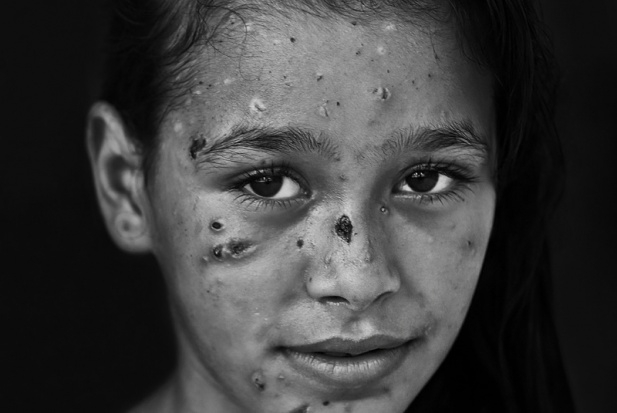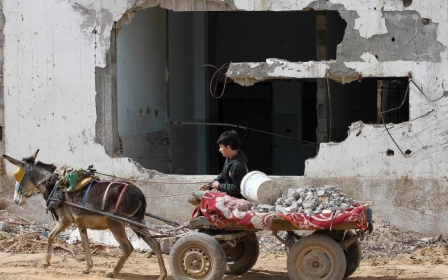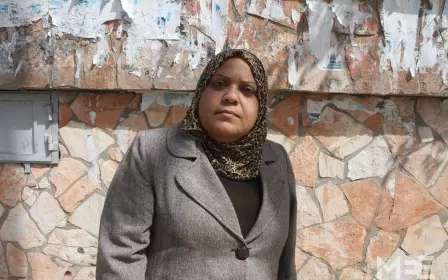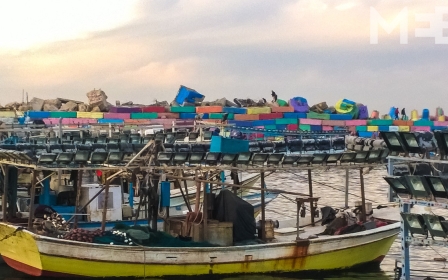Dalia Khalifa: Gaza's 'unbreakable' girl

Nine-year old Dalia Khalifa was in the living room of her family home in the Zaytoun district of the besieged Gaza Strip when an Israeli strike hit their house during last summer's Operation Protective Edge.
On the dawn of 1 August, 2014, she was rushed to Gaza's Shifa Hospital, where other members of her family – and many compatriots – were being treated.
Covered in blood and unable to open her eyes, with her younger sister clinging to her crying out "I love you," she wasn't aware where she was and what her surroundings were until she gradually recovered.
Her story was narrated by Mohammed Asad, a photojournalist from Gaza, who happened to be in the same hospital documenting civilian casualties of Israel's military offensive.
"When I saw her, the image of the Afghan girl Sharbat Gula came to my mind," Asad told MEE, in a reference to the famous photo by Steve McCurry published in the National Geographic.
Asad took a photo of Dalia on 9 August, 2014, noting that despite the shrapnel wounds to her face, she did not cry. The name given to the photo was "Assiyat al-Damea," which translates to "the one who does not cry easily". The English name given to the photo was simply "unbreakable".
The photo has recently become the Grand Jury Winner in a photography competition organised by the United Nations Office for the Coordination of Humanitarian Affairs in the Middle East and North Africa (OCHA).
Asad met Dalia again on Tuesday, taking new photos of her with family and classmates.
"She is still strong-willed today," said Asad, adding that her question to the Israelis remains: "What have we done to you to deserve this?"
Her mother, Um Zuhair, and father, Rizk, recalled to Asad the events of that tragic night.
"A tank-shell fell on our house at around 3am without any prior warning. We were all sleeping in the middle of the house and the will of God dictated that we'd all survive," she said.
"But the children had been injured and the neighbours came to their aid and took them to hospital," she added.
Dalia's father said that while some of the traces of shrapnel on her face are vanishing, her body remains riddled with shrapnel scars. What's worse, he added, is the more serious medical case of her younger sister Remas, whose skull was injured as a result of the Israeli strike.
Both girls need medical attention as well as cosmetic surgery, but the shut borders with Egypt and Israel means that they can't travel to receive treatment in Turkey nor receive specialist doctors who are willing to travel to the besieged Gaza Strip.
"Dalia’s face charts the pain of Gaza’s children. But also the unrelenting beauty and courage of a generation that seems determined to withstand the seemingly insurmountable hardships," commented Ramzy Baroud, Palestinian author and journalist.
"The fact that life never stood still for the nine-year-old girl, that she is back at school, although the shrapnel have dotted every inch of her frail body is a testament to Gaza's unbreakable will after the war, that there can be no defeat if there is no surrender," he added.
Asad, who reported extensively on the plight of civilians during Israel's 2014 military offensive, had endured having his own house blown up by an Israeli strike.
On a separate occasion, he was spared being hit by an Israeli drone missile that landed a few metres away from him, killing one child and injuring two people.
"Mohammed Asad is a gifted photographer. He reports on a story on which he is part; charts the suffering that he lives, and paints the wounded faces, as that of Dalia, as he too carries the scars of war and abandonment," said Baroud.
"Dalia and Mohammed are the enduring hope of Gaza."
Middle East Eye propose une couverture et une analyse indépendantes et incomparables du Moyen-Orient, de l’Afrique du Nord et d’autres régions du monde. Pour en savoir plus sur la reprise de ce contenu et les frais qui s’appliquent, veuillez remplir ce formulaire [en anglais]. Pour en savoir plus sur MEE, cliquez ici [en anglais].




